#Emperor Vespasian
Text

#what their mums probably called them#ancient rome#roman empire#ancient history#julio claudian dynasty#emperor augustus#emperor tiberius#emperor caligula#emperor claudius#emperor nero#emperor galba#emperor otho#emperor vitellius#emperor vespasian#emperor titus#emperor domitian#emperor nerva#emperor trajan#emperor hadrian#emperor antoninus pius#emperor lucius verus#emperor marcus aurelius#emperor commodus#augustus#tiberius#claudius#caligula#nero#galba#otho
34 notes
·
View notes
Text

2,000-Year-Old Roman Villa Discovered in Naples
A three-year project to build a children’s playground and recreation area south of the Italian city of Naples has unearthed the ruins of a 2,000-year-old clifftop beach house.
Built in the first century, the panoramic mansion — which overlooks the islands of Ischia and Procida — is now partly flooded by the sea. Experts believe it could have once been the opulent residence of Pliny the Elder, the legendary author, naturalist, and commander of the Roman navy fleet stationed there.
The discovery, made last week in the coastal town of Bacoli, unearthed the thick perimeter stone walls of 10 large rooms with floors, tiled walls and a maze of intact panoramic outdoor terraces.
Back in the first century, the mansion would have been located within the Roman port at Misenum, where for four centuries a fleet of 70 ships controlled the Tyrrhenian Sea, the security of which was key to holding the western flank of the Roman empire.

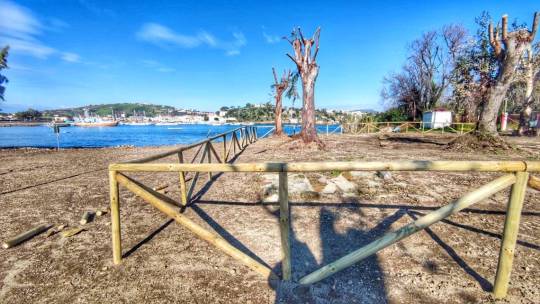
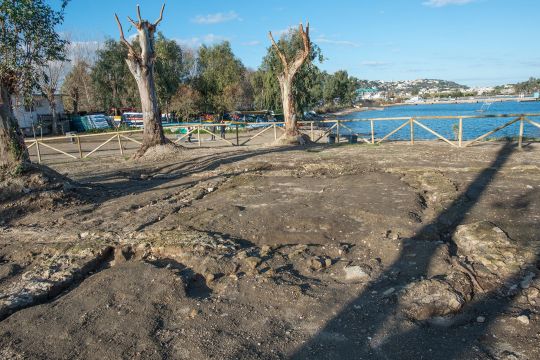
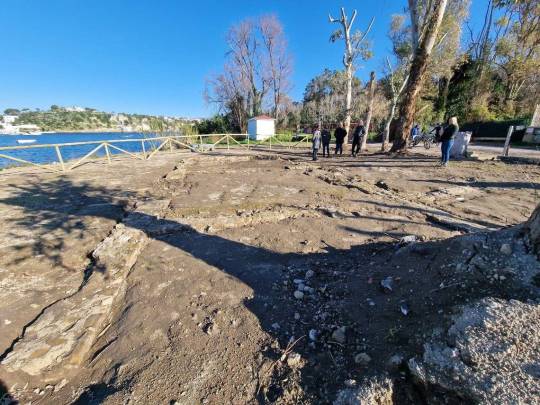
“It is likely that the majestic villa had a 360-degree view of the gulf of Naples for strategic military purposes,” Simona Formola, lead archaeologist at Naples’ art heritage, said in an interview. “We think (the excavation of) deeper layers could reveal more rooms and even frescoes — potentially also precious findings.”
Authorities were surprised by the elaborate style of the walls, which were constructed with diamond-shaped tufa (limestone) blocks placed in a net-like ornamental pattern about 70 centimeters (27.5 inches) below ground.
The villa runs down to a little crumbling stone dock now located about four meters below sea level. That this — and other parts of the unearthed villa — are now underwater is due to the phenomenon of “negative bradyseism,” a term used to describe the gradual descent of the earth’s surface into the sea in areas exposed to frequent volcanic activity. (The area borders a moon-shaped “caldera” or extinct volcanic crater).
Digs will continue in coming months, with authorities hoping to shed further light on not only the form of the beach villa itself, but the broader life and structure of Misenum, one of the most important colonies in the Roman Empire.
“The discovery is even more exceptional given that we know very little (about) the port of Misenum,” said Formola.


As well as acting as a lookout point, Pliny’s beach villa would have also likely been used for leisure. The private dock was where he would greet high-ranking guests arriving by sea for lavish parties. Many Ancient Romans used to flock to Bacoli and the surrounding area, to enjoy their vacation homes and the region’s thermal baths and spa retreats.
Bacoli is located within the so-called “Phlegraean Fields” (or “Fire Plains”), which are dotted with natural geysers and tiny active craters where there are still frequent earthquakes. Due to its blazes and sulphureous vapors, the ancients believed it to be the entrance to the underworld and had dubbed it “the Mouth of Hell.” Indeed it’s possible that Pliny the Elder would have witnessed the eruption of Mount Vesuvius in AD 79 from the villa. It is known he died trying to rescue those fleeing the calamity.
While archaeologists were reportedly surprised by the finding, local lore had long speculated on the existence of an underground treasure in this location. On the beach neighboring the newly-discovered villa walls, a large brick ruin had been dubbed the “talking wall” by local residents as, in their view, it proved the one-time existence of a large residence.
The site will now become an open-air museum, set to open in the coming weeks. “The ruins of the Roman villa will be cleaned and cordoned-off with wooden fences,” said Bacoli’s mayor Josi Gerardo Della Ragione. “They will be the core of this beautiful space which… our citizens and visitors will get to admire.”
By Silvia Marchetti.

#2000-Year-Old Roman Villa Discovered in Naples#Roman port at Misenum#Pliny the Elder#Emperor Vespasian#Mount Vesuvius#ancient ruins#ancient city#ancient artifacts#archeology#archeolgst#history#history news#ancient history#ancient culture#ancient civilizations#roman history#roman empire
33 notes
·
View notes
Text

A Tale of Two Coins - 2000 years apart!
On the right is a Judea Capta coin from 71 AD, 1952 years ago. The coin says “Judea conquered" in latin. These were commemorative coins originally issued by the Roman Emperor Vespasian to commemorate the capture of Judea and the destruction of the Jewish Second Temple by his son Titus in 70 CE during the First Jewish Revolt. On one side of the palm tree is a weeping defeated Jewish woman. On the other a victorious Roman soldier.
On the left, we see the same palm tree representing the Jewish homeland, but instead of a Roman soldier, there is a Jewish woman holding a baby up to the heavens symbolizing the rebirth of the Jewish people like a phoenix out of the ashes. In place of the weeping woman is a Jewish farmer (her husband) planting new roots for the Jewish people in the Jewish homeland. Instead of “Judea Capta'' the words read - “Israel Liberated 1948″.
These two coins sum up the history of exile and return of the indigenous Jews to the Kingdom of Israel.
In the prophetic words of the Bible: “They who sow in tears shall reap in joy.” (Psalm 126)
#secular-jew#israel#jewish#judaism#israeli#jerusalem#diaspora#secular jew#secularjew#islam#coins#ancient coins#judean coinage#judea#samaria#romans#judea capta#vespasian#titus#emperor#roman empire#Israel liberated#1948#hamas#coinage#second temple#1st century#palestine#Palestinian#gaza
384 notes
·
View notes
Text
I need everyone to watch Those About To Die immediately because it's AMAZING thx



#those about to die#Cala#Tanax#ancient rome#gladiators#chariot races#emperors#Scorpus#Domitian#Titus#Vespasian
35 notes
·
View notes
Text
Possible spoilers for dragons rising season 2 ahead
this is a theory based on new leaks, so it might contain spoilers
So we just got a first concrete leak of the Story for dragons rising season 2
So Ras is apparently trying to free the forbidden five, five evil and powerful elemental masters, who once ruled the world. This being a lego series and needing drama, he will likely succeed in this, which might mean, that the tournament in summer truly is another tournament of elements, only this time between two actual sides, instead of a kind of battle royale.
The forbidden five were first mentioned in the description of the garmadon comic coming out later this year, which ties into the plot of season 2. If i remember correctly, that comic plays at around the same time, as the serpent wars, so the forbidden five might have been banished sometime around then. So here is my listing, of who they might be:
Cinder:
maybe he was the elemental master of smoke at the time of the serpent wars, because if i recall we never saw that EM in any of the flashbacks. Maybe he was banished to another realm, possibly the Wyldness, and had his powers taken from him, which went on later to find a new host in Ash, who we met during the original tournament of elements. Maybe the Source dragon Energy Ras now has thanks to Jordana is going to be used to restore Cinder‘s powers and make him an elemental master again. This could be Ras plan for all pf the five, which is why he might need a lot of source dragon energy.
2. a past EM of metal
we never saw the EM of metal before Karlof, so maybe they were one of the forbidden five and were banished, with their powers finding a new host in Ninjago.
3. a past EM of shape
we never saw an EM of shape before Chamille, although granted, they could have looked however they wanted and we would have no way of knowing if the might have been the unknown elemental master, seen in the flashback, in which case they were not one of the forbidden five

this is the EM fro. the flashback i‘m talking about
4. past EM of mind
same story as the two above, with Mind possibly being more likely to have been the power of a ruler due to its power to, well, control the minds of others
and finally
5. the EM of an unknown element
now, while we do not know this Elemental masters element, we have actually seen both the master and their element being used. The only thing is, that this elemental master is dead. My theory is, that his element was some sort of energy, which he used to create incredibly advanced Technology. After he and the other forbidden five were defeated and banished, some of his loyal followers came with him into exile, into a realm of many dragons, where they used his power and technology to build themselves a kingdom. The many dragons, or the fact that he had children after being banished, might have meant that his power did not find it‘s way back to ninjago, instead remaining in his older twin daughter and heir to his throne. The elemental masters name?
Levo, emperor of imperium and father of Zeatrix and Beatrix Vespasian-Orus, the former of whom inherited his powers

#ninjago#ninjago dragons rising#incoherent rambling#dragons rising season 2#theory#lord ras#ninjago cinder#cinder#ninjago lord ras#ninjago ras#ninjago levo#emperor levo#ninjago zeatrix#zeatrix#ninjago empress beatrix#empress beatrix#beatrix vespasian-orus
26 notes
·
View notes
Text
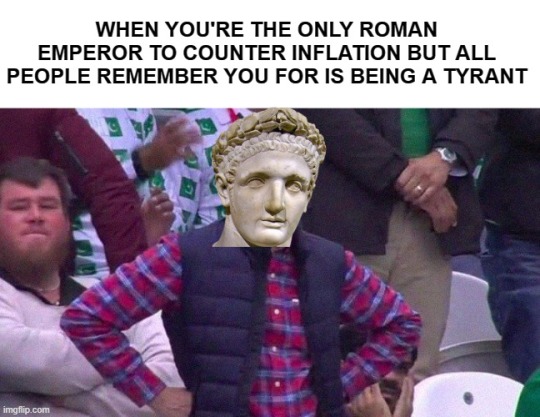
Happy birthday, Domitian!
I appreciate you man, dw.
7 notes
·
View notes
Text

Horse year
0 notes
Text











DOMUS AUREA - Rome.
Photos: Andreas Wiessner (March 10, 2024)
After the great fire in Rome on July of 64, Emperor Nero ordered the construction of a new palace. Nero was not interested in politics and even less in military affairs, his true interest was art: music, theater, poetry and beautiful works.
The palace was built on the neighborhoods destroyed by the fire and called DOMUS AUREA (Golden House). Nevertheless, he only lived there for a few months before his death.
Three years later, Emperor Vespasian took all the treasures of Nero's palace and, added to the gold and treasures of the temple of Jerusalem, ordered the construction of the Amphitheater known as The Colosseum in that place, as well as thermal baths and other facilities that brought joy to the people.
Even so, part of the ruins of the Domus Aurea emerged and are now an archaeological site.
524 notes
·
View notes
Text


metal detectorist on the thames foreshore showed me this roman coin he found (not on the thames foreshore). it’s from the emperor vespasian’s 6th consulship so 75 ce? wild
#mudlarking#<- ok it’s not but it’s going in my tag#this was also a different conversation from the book recommendations. that was a whole other person#coins#beeps
46 notes
·
View notes
Text
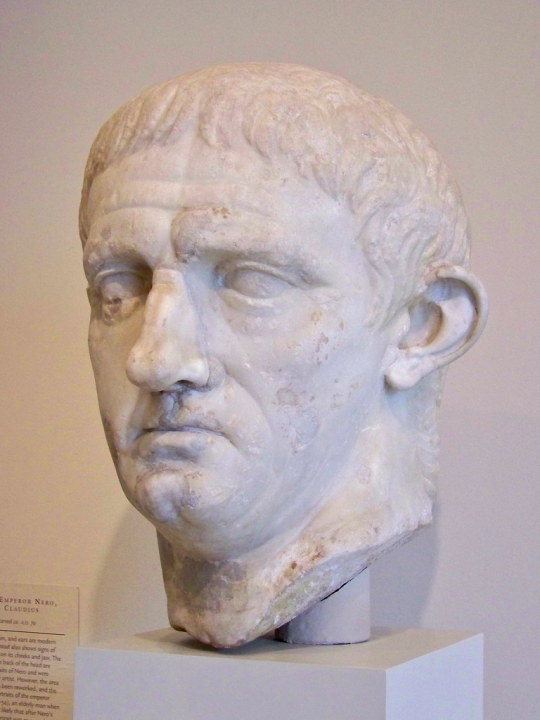
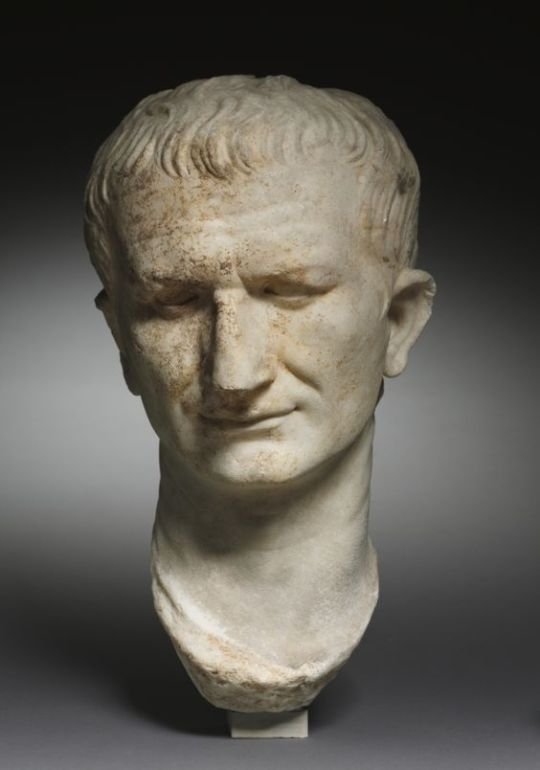
Two heads which show signs that they originally belonged to the portrait of Emperor Nero. After Nero's fall, they were recarved into Claudius, his predecessor, and Vespasian, his ultimate successor.
#ancient rome#roman empire#ancient art#ancient culture#ancient history#emperor claudius#emperor nero#emperor vespasian#julio claudian dynasty#These recarved heads always end up looking awkward and clunky
84 notes
·
View notes
Text

Roman Coin - Gold Aureus of Vespasian
AD 71
Portrait of Vespasian. Reverse: COS III FORT RED. Fortuna holding a globe and caduceus. Fortune' the Bringer-back' ensures that the emperor returns safely from his travels.
Vespasian (17 November 9 AD – 23 June 79) was Roman emperor from 69 to 79. The fourth and last emperor who reigned in the Year of the Four Emperors, he founded the Flavian dynasty that ruled the Empire for 27 years. His fiscal reforms and consolidation of the empire generated political stability and a vast Roman building program.
Vespasian was the first emperor from an equestrian family and only rose later in his lifetime into the senatorial rank as the first member of his family to do so. Vespasian's renown came from his military success; he was legate of Legio II Augusta during the Roman invasion of Britain in 43 and subjugated Judaea during the Jewish rebellion of 66.
While Vespasian besieged Jerusalem during the Jewish rebellion, emperor Nero committed suicide and plunged Rome into a year of civil war known as the Year of the Four Emperors. After Galba and Otho perished in quick succession, Vitellius became emperor in April 69. The Roman legions of Roman Egypt and Judaea reacted by declaring Vespasian, their commander, the emperor on 1 July 69.
In his bid for imperial power, Vespasian joined forces with Mucianus, the governor of Syria, and Primus, a general in Pannonia, leaving his son Titus to command the besieging forces at Jerusalem. Primus and Mucianus led the Flavian forces against Vitellius, while Vespasian took control of Egypt. On 20 December 69, Vitellius was defeated, and the following day Vespasian was declared emperor by the Senate.
#Roman Emperor Vespasian#Roman Coin - Gold Aureus of Vespasian#AD 71#collectable coins#gold#gold coins#roman coins#ancient artifacts#archeology#archeolgst#history#history news#ancient history#ancient culture#ancient civilizations#ancient rome#roman history#roman empire#roman art
37 notes
·
View notes
Text
Free!
"Leave our country alone!"
they say
"This isn't your land -
go back to where you came from!"
And as my brother's being shoot,
And my sister's being paraded naked -
For their great sin of: living
[Re'im, Israel, 2023]
As my great-grandfather was pushed down in the streets
And his beard was brutally shaved
As they raped and enslaved and murdered-
[Birkenau, Poland, 1943]
[just like in 1941 Farhud, Iraq ; Jedwabne pogrom; 1945 Tripoli pogrom, the 1946 Kielce pogrom, and the 1947 Aleppo pogrom]
In 1934 there were pogroms against Jews in Turkey and Algeria.
Other parts of my family were lucky enough to survive the 1929 Hebron massacre during the 1929 Palestine riots.
[Mandatory Palestine under British administration]
In 1919, soldiers marched into the center of town accompanied by a military band and engaged in atrocities under the slogan: "Kill the Jews, and save the Ukraine." They were ordered to save the ammunition in the process and use only lances and bayonets during the Proskurov pogrom.
[Proskurov, Ukraine, 1919]
[100 years, and nothing changed, huh?]
You know, my grandma's arab. I still remember sitting in class in high school, hearing about the 1840 Damascus affair, and thinking:
hu.
I'll skip several years and countries, but:
Their grandparents were there to witness as the outbreak of violence against Jews (Hep-Hep riots) occurred at the beginning of the 19th century.
The 1821 Odessa pogroms marked the beginning of the 19th century pogroms in Tsarist Russia
That's Khmelnytsky Uprising of 1648–1657 in present-day Ukraine.
So they said, during the attacks against Jews also took place in Barcelona and other Catalan cities during the massacre of 1391.
Their ancestors were cast away and murdered in Spain, 1492.
The same way we were banished and cast away from Bern (1427) and Zürich (1436) for almost 400 years?
Let us not speak of the alaughter on Holy Saturday of 1389, a pogrom began in Prague that led to the burning of the Jewish quarter, the killing of many Jews, and the suicide of many Jews trapped in the main synagogue; the number of dead was estimated at 400–500 men, women, and children.
Brussels massacre of 1370.
Or - do you want to hear about the 510 jewish communities that were destroyed? (1348-1350)
including in Toulon, Erfurt, Basel, Aragon, Flanders[16][17] and Strasbourg.[18]
Just like Rhineland massacres in 1096
Some of them made it to England, around 1060.
It took less than 30 years for the first Podrom in 1189-90 in England,
Oh, and let us not forget 1066 Granada massacre [again, in Spain].
Or the Alexandria in the year 38 CE, followed by the more known riot of 66 CE.
The Jewish population of the land on the eve of the first major Jewish rebellion [66 CE] may have been as high as 2.2 million. The monumental architecture of this period indicates a high level of prosperity.
In 66 CE, the Jews of Judea rose in revolt against Rome, sparking the First Jewish–Roman War. The reverse seized control of Judea and named their new kingdom "Israel"
The revolt was crushed by the Roman emperors Vespasian and Titus. The Romans destroyed much of the Temple in Jerusalem and took as punitive tribute the Menorah and other Temple artifacts back to Rome. Josephus writes that 1,100,000 Jews perished during the revolt, while a further 97,000 were taken captive. The Fiscus Judaicus was instituted by the Empire as part of reparations.
[And here we come to a full cycle of blood, land, and pain].
And those are only those I found out about. Only those we have a record of. Only those we know to this day. They were so massive, or left enough impact so we still remember.
[I could go on, this is just a short list.]
It seems like no matter what we do, we'll always be accused for
Let me know, please - where can I be a jew, and just
Live?
#israel#jews#jewish history#history#palestine#Juda kingdom#pogrom#pogroms#terror#manslaughter#massacre
143 notes
·
View notes
Text
After Nero died, the Senate condemned his memory. Many of Nero’s portraits were re-carved to commemorate other emperors. Here’s one that was reconfigured to look like his stepfather, Claudius:

And another remade to look like one of his successors, Vespasian. We can tell it was originally Nero because they had to trim Nero’s long hair in the back, and Nero’s overbite still shows.

Click on the link for more on Nero's complicated legacy:
{Buy me a coffee} {WHF} {Medium} {Looking Through the Past}
94 notes
·
View notes
Photo

Josephus on Christianity
Titus Flavius Josephus (36-100 CE), the Jewish historian, is the main source for understanding Second Temple Judaism in the 1st century CE. In the last decades of the 1st century CE, he wrote The Jewish War, the Antiquities of the Jews, Against Apion, and The Life of Flavius Josephus. His histories and eyewitness testimonies remain essential to the study of the historical context that gave rise to the origins of Christianity.
Josephus
Flavius Josephus was born Yosef ben Matityahu, a member of a priestly household in Jerusalem through his father’s side (the house and order of Jehoiarib), and his mother was of royal descent (Hasmonean). He was educated in Jerusalem and most likely shared ideology and sympathy with the party of the Pharisees.
During the Great Jewish Revolt of 66 CE, Josephus was appointed the commander of Galilee. He became famous (and infamous) for changing sides during the siege at Jotapata. He successfully predicted that the Roman commander, Vespasian (r. 69-79 CE), would become the next Roman emperor. Vespasian spared his life, and Josephus spent the rest of the war as a consultant to Vespasian’s son Titus (r. 79-81 CE), who ultimately destroyed Jerusalem and the Temple complex in the year 70 CE. After the war, Josephus moved to Rome where he had access to archives and wrote his histories.
The writings of Josephus are crucially important for several disciplines: Second Temple Judaism in the 1st century CE, background sources for early Christianity, historical details of the client kings of the Roman Empire in the East, and the line of the Julio-Claudian emperors in Rome. Considered one of the greatest traitors by Jews, Christians were the ones who preserved his writings for posterity. This is because he wrote about John the Baptist, reported the death of Jesus’ brother, James, and provided a passage on Jesus himself.
Continue reading...
33 notes
·
View notes
Text
17 Tammuz 5784 (22-23 July 2024)
The Roman siege of Jerusalem in 3830 brought a brutal end to four years of rebellion against the Roman occupation of Judaea and Galilee. Eretz Yisroel had been under some form of foreign occupation for almost the entire period since the end of the Babylonian captivity, from the Persians to the Seleucid Greeks to the Romans, and had the history of the successful Maccabee Rebellion to look back on, which had ended with the closest thing to Jewish political autonomy during the whole second temple period.
The rebellion began in 3826, one of several rebellions against the excesses of Nero’s reign, including others led by Roman provincial governors. It combined Jewish religious objections to being governed by a polytheistic empire with widespread rage at the brutality of Roman military occupation and excessive taxation. The rebellion brought together nearly all classes of Judaean society and all the major socioreligious factions of Jewish life, with even the staunchly apolitical Pharisees throwing their support behind the rebellion. However as the conflict raged on the ideological and class differences of the Jewish combatants led to brutal internal strife which weakened the effort to cast off Roman tyranny.
The chaos throughout the Roman Empire during this period led to hope of Roman withdrawal and retrenchment to smaller imperial borders, especially when Vespasian, who had been leading the Roman assault on the rebels, took a large portion of his forces back to Rome to seize imperial power at the end of the bloody year of the four emperors in 3829. But the Romans were determined not to lose any of their subjugated territories, and Vespasian soon sent reinforcements back to his sons Titus and Domitian. The tide then turned against the rebels.
The seige of Jerusalem began just before Pesach in 3830, when the city’s population was swelled by Jewish pilgrims from across the Roman and Parthian empires. These visitors were trapped within the city’s walls with its permanent inhabitants, severely straining the city’s stockpiles of food and water. Disease and hunger were as deadly in the siege as the foreign army, and Jerusalem’s defenders soon turned on each other as tensions and rivalries reached the breaking point and every faction sought to blame the others for the horrible situation.
It was on the seventeenth of Tammuz that the Roman armies broke through the third and final defensive wall around the city. By the end of the month Jerusalem had been almost entirely leveled in a series of fires that broke out during the Roman massacre of much of the surviving population. Nearly a hundred thousand Jewish survivors were forced into slavery and taken elsewhere in the empire. Scholars estimate that less than ten percent of Jerusalem’s pre-war population remained in the area by the end of the year. The revolt’s suppression had brought untold horrors upon Judaism’s holiest city.
The seventeenth of Tammuz soon replaced the ninth of Tammuz, which was the anniversary of the Babylonian army’s breach of Jerusalem’s walls at the end of the thirty month siege of the city, as a sunrise to sunset fast day. Because the Roman destruction of the Beit haMikdash occurred on the same Hebrew date as the Babylonian destruction of the temple built by Solomon, there was no need to change the date of that observance.
The period from the seventeenth of Tammuz to the ninth of Av is known as the Three Weeks, and is observed in many Jewish communities as a mourning period for the physical and spiritual exile created by the destruction of both temples. Communities that consider post-exilic rabbinical Judaism to be a superior development to the sacrificial order and which celebrate the cultural vibrancy of diaspora Judaism over the longing for return are correspondingly less likely to emphasize the Three Weeks.
#hebrew calendar#jewish calendar#Jewish grieving#Jewish fast days#jewish#judaism#jumblr#Roman occupation#The Great Jewish Revolt#sieges of jerusalem#Tammuz#17 Tammuz#🌖
29 notes
·
View notes
Text
Pecunia non olet
When the Roman emperor Vespasian reinstated Nero's very unpopular tax on the distribution of urinals' waste, sometime around 70 AD, his son and heir, Titus, complained about it, thinking it was vile and disingenuous. Vespasian shoved a golden coin under his nose and asked the young fool if he still felt offended about it. Pecunia non olet - money doesn't smell, son. This very gold comes from, well, urine. Live with it.
I once comforted a whole orphanage, in Moulmein, Burma, for three weeks, with about 500 well-spent US dollars, at the local bazaar and shops. From rice to fruits to the strange, exuberant vegetables of the Tropics, meat and eggs and chocolate, and for good measure, aspirin, band-aid, antiseptic wipes, notebooks, pencils, socks, shoes, Tshirts, skirts and trousers. Filled three rickshaws with all the boxes and bags and went for it. The St Joseph orphanage was run by five formidable Anglo-Indian nuns, who took care of about 40 children, aged 5 to 16, whose parents died in the horrendous floods that followed the Nargis cyclone, in 2008. They had nothing. When they asked me who I was, I honestly told them it did not matter. Non nobis, Domine, non nobis.
Make no mistake. I am not a saint. I smoke like a chimney and swear like a drunken sailor and sometimes have to professionally, elegantly lie, because such is the nature of my job. I am cynical and short-tempered and yes, less impatient now than at 20. That day in Moulmein will always shine bright in my mind and in my heart for its absurd joy. And also for the feeling the real generosity was not mine, that day, but theirs.
Last week-end, about 200 women I would probably find perfectly insufferable paid from 2000 to 5000 US dollars each, to meet and greet and fawn and take #silly pictures with three guys who happen to be part of the cast of a certain TV series. With only one of them, in reality, but let's not trouble the waters. Apparently, they had a good time. I am not sure about the guy: he's not exactly the Svengali type. I very much doubt that this event will go down in history. It was as good as it gets, with the people it could attract. Entitled? Maybe. Sad? A bit, if you ask me. But above and beyond all of this, it was transactional. I pay, you drop by. I pay, you take a pic and smile. I pay, I ask a stupid question. I pay, we have a dram. For our mutual benefit.
I have no idea if these people maxed out their credit cards to be there. In theory, this is all about disposable income, cash that can and will be well... disposed of, somehow, whether it's a horrendous pair of mauve shoes or the last gadget or hey, a meet and greet. If I were Marie Kondo, I'd even dare say that parting with cash brought them joy.
Can we compare the two moments? Of course not. But both of them are the result of a (hopefully fully aware) choice.
It's been a long while I also chose to never set foot in such places, for such things. Not my circus, not my monkeys.
Stating the opposite is pure hypocrisy and pearl-clutching.

Sunset on the Salween River. Moulmein. Burma. August 2010. Taken by me.
100 notes
·
View notes